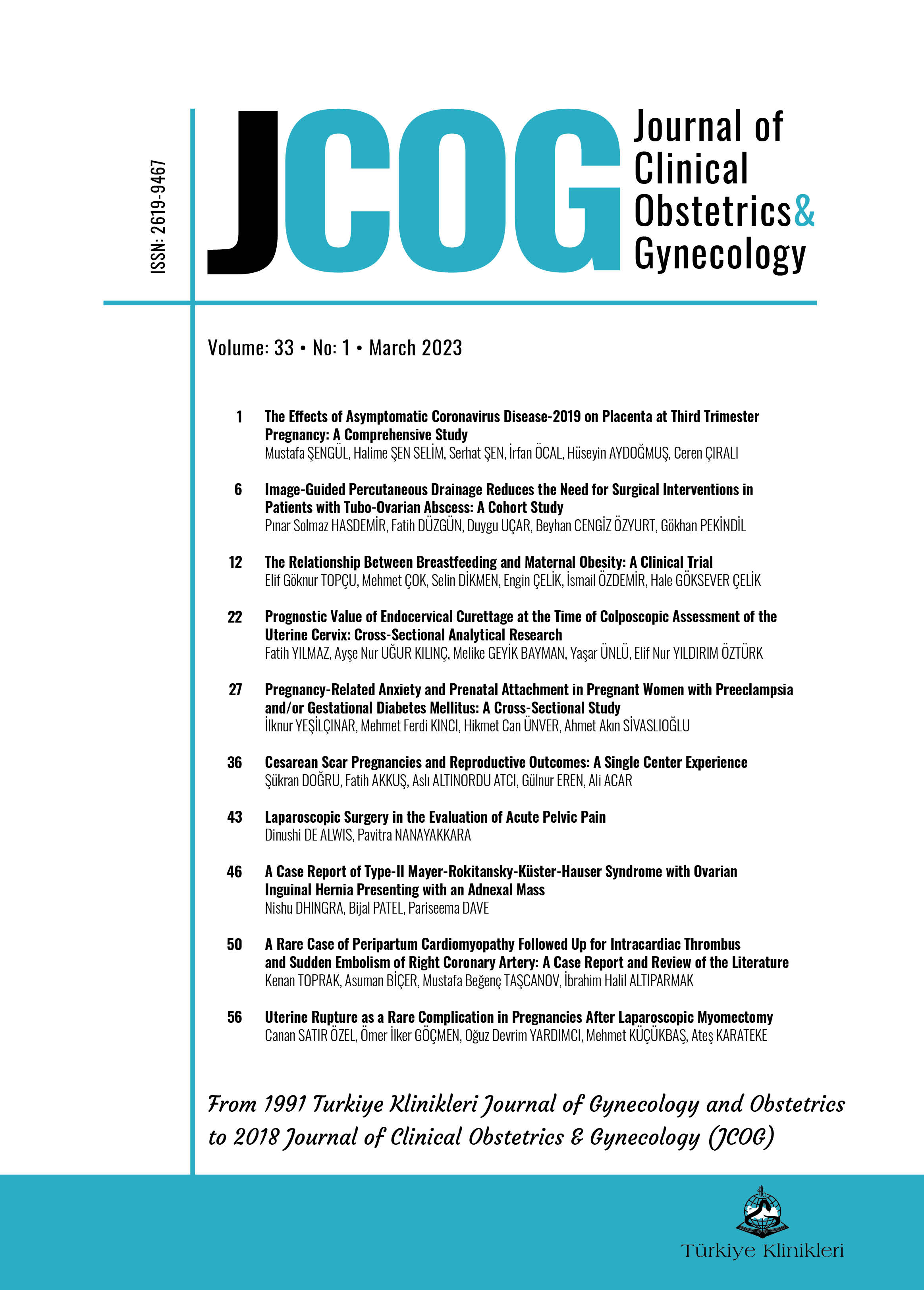Open Access
Peer Reviewed
ORIGINAL RESEARCH
1321 Viewed1327 Downloaded
The Effects of Asymptomatic Coronavirus Disease-2019 on Placenta at Third Trimester Pregnancy: A Comprehensive Study
Received: 29 Mar 2022 | Received in revised form: 07 Nov 2022
Accepted: 25 Nov 2022 | Available online: 01 Dec 2022
JCOG. 2023;33(1):1-5
DOI: 10.5336/jcog.2022-90084
Article Language: EN
Article Language: EN
Copyright Ⓒ 2025 by Türkiye Klinikleri. This is an open access article under the CC BY-NC-ND license (http://creativecommons.org/licenses/by-nc-nd/4.0/)
ABSTRACT
Objective: By the time coronavirus disease-2019 (COVID-19) had been announced as pandemic, the disease was shown to have a great risk among pregnant woman if lower respiratory system is involved. We aimed to describe clinical characteristics of deliveries with asymptomatic COVID-19 infection, investigate transplacental transmission, and compare first-line histopathological findings with healthy controls. Material and Methods: We conducted a prospective cohort study of consecutive term deliveries at our tertiary hospital's obstetric unit between March and November 2021. Forty-five patients with asymptomatic reverse transcription-polymerase chain reaction (RT-PCR) positivity were matched with 45 controls with negative RT-PCR testing. All newborns of mothers with positive RT-PCR results for COVID19 underwent a nasopharyngeal swab following delivery, and Apgar scores of the newborns were extracted from pediatric charts. Placentas were transported and fixated in 10% formaldehyde solution before pathological evaluation. Results: There were no significant differences in Apgar scores, birth weights, head circumferences, birth height, and genders between the 2 groups. RT-PCR results were negative in all of the newborns, indicating no vertical transmission. Placental focal and global calcification, and choriamnionitis frequencies were similar between the groups, whereas placental fibrin deposits were significantly more frequent in the placentas of infected pregnancies. Conclusion: There was no evidence of vertical transmission and any characteristic feature in the placentas of pregnancies with asymptomatic COVID-19 infection. Although no significant clinical implication was found, increased perivillous fibrin deposition in the study group could be a baseline step for the progression of perinatal infection.
Objective: By the time coronavirus disease-2019 (COVID-19) had been announced as pandemic, the disease was shown to have a great risk among pregnant woman if lower respiratory system is involved. We aimed to describe clinical characteristics of deliveries with asymptomatic COVID-19 infection, investigate transplacental transmission, and compare first-line histopathological findings with healthy controls. Material and Methods: We conducted a prospective cohort study of consecutive term deliveries at our tertiary hospital's obstetric unit between March and November 2021. Forty-five patients with asymptomatic reverse transcription-polymerase chain reaction (RT-PCR) positivity were matched with 45 controls with negative RT-PCR testing. All newborns of mothers with positive RT-PCR results for COVID19 underwent a nasopharyngeal swab following delivery, and Apgar scores of the newborns were extracted from pediatric charts. Placentas were transported and fixated in 10% formaldehyde solution before pathological evaluation. Results: There were no significant differences in Apgar scores, birth weights, head circumferences, birth height, and genders between the 2 groups. RT-PCR results were negative in all of the newborns, indicating no vertical transmission. Placental focal and global calcification, and choriamnionitis frequencies were similar between the groups, whereas placental fibrin deposits were significantly more frequent in the placentas of infected pregnancies. Conclusion: There was no evidence of vertical transmission and any characteristic feature in the placentas of pregnancies with asymptomatic COVID-19 infection. Although no significant clinical implication was found, increased perivillous fibrin deposition in the study group could be a baseline step for the progression of perinatal infection.
REFERENCES:
- WHO [Internet]. © 2023 WHO. WHO Director-General's opening remarks at the media briefing on COVID-19 - 11 March 2020. Available from: [Link]
- Patanè L, Morotti D, Giunta MR, Sigismondi C, Piccoli MG, Frigerio L, et al. Vertical transmission of coronavirus disease 2019: severe acute respiratory syndrome coronavirus 2 RNA on the fetal side of the placenta in pregnancies with coronavirus disease 2019-positive mothers and neonates at birth. Am J Obstet Gynecol MFM. 2020;2(3):100145. [Crossref] [PubMed] [PMC]
- Facchetti F, Bugatti M, Drera E, Tripodo C, Sartori E, Cancila V, et al. SARS-CoV2 vertical transmission with adverse effects on the newborn revealed through integrated immunohistochemical, electron microscopy and molecular analyses of Placenta. EBioMedicine. 2020;59:102951. [Crossref] [PubMed] [PMC]
- Hosier H, Farhadian SF, Morotti RA, Deshmukh U, Lu-Culligan A, Campbell KH, et al. SARS-CoV-2 infection of the placenta. J Clin Invest. 2020;130(9):4947-53. [Crossref] [PubMed] [PMC]
- Schwartz DA, Morotti D. Placental Pathology of COVID-19 with and without Fetal and Neonatal Infection: Trophoblast Necrosis and Chronic Histiocytic Intervillositis as Risk Factors for Transplacental Transmission of SARS-CoV-2. Viruses. 2020;12(11):1308. [Crossref] [PubMed] [PMC]
- Langston C, Kaplan C, Macpherson T, Manci E, Peevy K, Clark B, et al. Practice guideline for examination of the placenta: developed by the Placental Pathology Practice Guideline Development Task Force of the College of American Pathologists. Arch Pathol Lab Med. 1997;121(5):449-76. [PubMed]
- Chen S, Huang B, Luo DJ, Li X, Yang F, Zhao Y, et al. [Pregnancy with new coronavirus infection: clinical characteristics and placental pathological analysis of three cases]. Zhonghua Bing Li Xue Za Zhi. 2020;49(5):418-23. Chinese. [PubMed]
- Costa ML, de Moraes Nobrega G, Antolini-Tavares A. Key infections in the placenta. Obstet Gynecol Clin North Am. 2020;47(1):133-46. [Crossref] [PubMed]
- Robbins JR, Bakardjiev AI. Pathogens and the placental fortress. Curr Opin Microbiol. 2012;15(1):36-43. [Crossref] [PubMed] [PMC]
- Vivanti AJ, Vauloup-Fellous C, Prevot S, Zupan V, Suffee C, Do Cao J, et al. Transplacental transmission of SARS-CoV-2 infection. Nat Commun. 2020;11(1):3572. [Crossref] [PubMed] [PMC]
- Mongula JE, Frenken MWE, van Lijnschoten G, Arents NLA, de Wit-Zuurendonk LD, Schimmel-de Kok APA, et al. COVID-19 during pregnancy: non-reassuring fetal heart rate, placental pathology and coagulopathy. Ultrasound Obstet Gynecol. 2020;56(5):773-6. [Crossref] [PubMed] [PMC]
- Ng WF, Wong SF, Lam A, Mak YF, Yao H, Lee KC, et al. The placentas of patients with severe acute respiratory syndrome: a pathophysiological evaluation. Pathology. 2006;38(3):210-8. [Crossref] [PubMed] [PMC]
- Baergen RN, Heller DS. Placental pathology in Covid-19 positive mothers: preliminary findings. Pediatr Dev Pathol. 2020;23(3):177-80. [Crossref] [PubMed] [PMC]
MENU
POPULAR ARTICLES
MOST DOWNLOADED ARTICLES





This journal is licensed under a Creative Commons Attribution-NonCommercial-NoDerivatives 4.0 International License.










